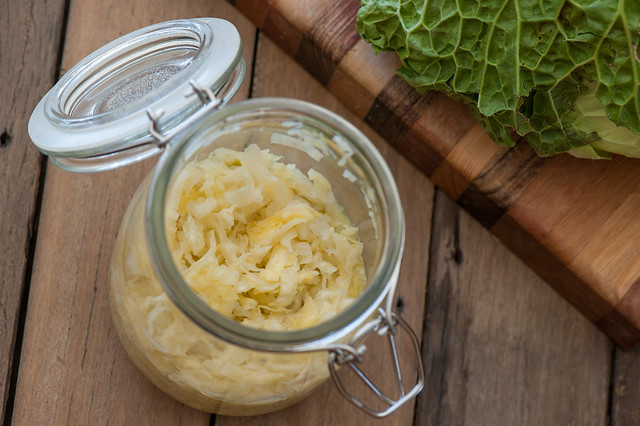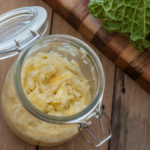
I was never a huge fan of sauerkraut until I started making my own. Being able to control how fermented or ‘funky’ your kraut gets makes a huge difference. If you’re new to fermenting vegetables though I’d really recommend starting with fermented carrots which are much much easier!
This method is called dry brining and when you read through the method it’s hard to imagine it working. I know I always thought that when looking at kraut recipes. It wasn’t until I actually saw Sandor Katz make kraut that I ‘got it’. So I recommend checking out the video as it’s much easier to show you rather than write.
UPDATE: Since I recorded this video I’ve refined my method. Instead of massaging the cabbage I just leave it to stand with the salt in a bowl for a few hours (at least 3 and as much as 12). This allows the salt to soften the cabbage and you can then easily pack it into the jars.

Simple Sauerkraut
Ingredients
- 1/2 head cabbage
- salt
Instructions
- Day 1. Cut cabbage in half lengthwise and trim the surfaces that were already cut. Remove outer leaves and discard. Finely slice the cabbage as well as you can. I use a knife because I like it rustic. But you could use a mandoline if you want really fine kraut.
- Place sliced cabbage in a large bowl. Sprinkle with a few generous pinches of fine salt as you go. You want at least 0.5% salt (which is about 1 tablespoon for 1/2 a large cabbage and 2 teaspoons for a smaller cabbage). I just add and mix and taste as I go. When the cabbage tastes slightly salty but still really fresh I leave it at that. (See notes below for more detailed quantities).
- Massage cabbage with your clean hands. Sandor recommends 10 minutes but I usually do it for a few minutes and then leave it to stand for at least 3 hours or up to 12 hours so the salt can work its magic. You want the moisture from the cabbage to come out.
- Pack the cabbage into a clean glass or ceramic jar. Press down firmly as you go to really release the moisture and pack it as tightly as possible. I like to use the back of a spoon. You want enough liquid to just cover the cabbage. If it looks too dry add a little filtered or boiled and cooled water. But be sparing as water will dilute the final flavour.
- Seal with the lid and leave on the kitchen bench.
- Day 2. Open the jar to release any gas buildup. Push the cabbage down to re-submerge. Taste.
- Day 3+. Repeat as per day 2 and taste again. If the cabbage tastes tangy enough for you, pop it in the fridge and start eating. If not leave it out of the fridge and continue to taste every day until you’re happy. Depending on the temperature and how funky you like your kraut it can take from 3 days to months.
Notes / Variations
different Veg – I like savoy cabbage but recently made a mix of savoy and red cabbage that was really pretty. Turnips, carrots, apple and cooked spuds can all be added.
flavourings – I haven’t tried any but celery seeds, curry spices, caraway seeds, or chilli can all be used.
quantity rule of thumb – 1kg veg will fill a 1L vessel and will need about 0.5% – 1% salt so about 5-10 grams (1-2 teaspoons). The more salt the crunchier your ferment will be.
if in doubt when tasting – pop it in the fridge because this will slow the fermentation down and you can always pull it back out if you decide later that it’s not strong enough for you.
different containers – don’t ferment in metal due to corrosion. Plastics can be OK but I prefer glass or ceramics so you can be certain there are no plastics leaching into the ferment.
floating veg – you can put a weight to hold down the veg as they tend to float. I usually don’t bother.
fill levels – don’t fill to the top due to expansion
light degrades some nutrients but generally light is OK. It doesn’t need to be in a dark cellar and is better in the kitchen where you won’t forget about them. Plus UV rays from the sun act as a mould inhibitor.
white mold – just skim and discard, they’re not toxic.
bright coloured molds – are toxic – discard the project. But don’t stress about this too much. No one has ever died from eating fermented vegetables.
Usage Suggestions
as a side – just plonk your kraut on the table to serve with whatever you’re having. Love it as an instant extra serve of veg.
for breakkie – serve with your morning eggs and a little bacon.
with bangers and mash – a brilliant accompaniment to this simple dish.
Prepare Ahead?
Absolutely. Takes 45 minutes + fermenting time.
Storage Best Practices
Store in an airtight container in the fridge. Will keep in the fridge for 3 months or so. If you get a white mould growing, just scrape it off. If it’s a black or other non white colour best to discard. Can be frozen but will change the texture.

 Add to my Old Favourite Recipes
Add to my Old Favourite Recipes


Did you know you can use sauerkraut juice to ferment macadamias and quinoa for a quick and easy sourdough bread?
I just made a batch of golden sauerkraut last week. Has grated ginger and turmeric and carrot added.
ooh yum Gillian!
I add some chilli flakes as well when I do a golden version.